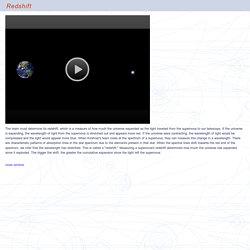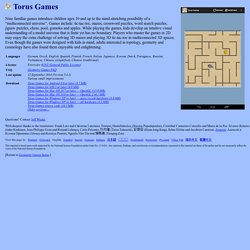

Telescope. Courbe. Ondes gravitationelles. Instruments de mesure basics. Telescopes actuels. Astrolabe. Optique. Spectroscopie. Grands observatoires. Visuals: Redshift. The team must determine its redshift, which is a measure of how much the universe expanded as the light traveled from the supernova to our telescope.

If the universe is expanding, the wavelength of light from the supernova is stretched out and appears more red. If the universe were contracting, the wavelength of light would be compressed and the light would appear more blue. When Kirshner's team looks at the spectrum of a supernova, they can measure this change in a wavelength. There are characteristic patterns of absorption lines in the star spectrum due to the elements present in that star. When the spectral lines shift towards the red end of the spectrum, we infer that the wavelength has stretched.
Lawrence Hall of Science. Astronomie: comment connait-on la distance et la composition des étoiles ? Bonne, très bonne question !

Et bien voici la réponse : tout ça ne s'est pas fait en un jour, et ce que nous connaissons de l'univers est le résultat de tout un tas de mesures et de déductions qui ont pris plusieurs siècles. Alors pour tout résumer dans une seule page web, ça ne va pas être de la tarte ! Et pourtant, ami lecteur, c'est ce que je te propose ici !
Navastro.
Sphère armilaire. Lunette galilée telescope Newton. Lesson Plan: Science and the Art of the Islamic World. EAAE Workshops. Supersite sur les modélisations univers. Un Atlas de l'Univers. Cosmos & Culture: How astronomy has shaped our world - an album on Flickr. Le crépuscule de l. Les méthodes de l'archéoastronomie Le principal instrument de cette spécialité de l'astronomie est le théodolite, avec lequel on détermine des alignements précis.

L'archéoastronomie est une branche de recherche interdisciplinaire appliquant les connaissances et les méthodes de l'astronomie aux pièces archéologiques anciennes utilisées à des fins astronomiques et à tous les ouvrages du génie humain auxquels les concepts astronomiques ont été appliqués. Les domaines de cette science ne se limitent pas à l'archéologie, à laquelle elle a apporté une contribution non négligeable, mais concernent également l'art, l'urbanisme et bien d'autres disciplines tout au long des siècles.
UVBead_bookmark.pdf. Origins: Hubble: Tools: The Center of The Universe. When astronomers look at distant galaxies to determine how fast they're moving, it looks like they're all moving away from us.

Does that mean we're at the center of the universe? Well, no. It turns out that every point in the universe sees itself as the center! You can show yourself why with this activity. Try this! - Use your mouse to drag the top (blue circle) layer randomly over the bottom one, the difference between the two is hard to see. Topology and Geometry. Images. Curved Spaces. Curved Spaces is a flight simulator for multiconnected universes.

Such toy universes are the 3D analog of the torus and Klein bottle on which the simpler 2D Torus Games are played. Because light itself wraps around such a space, inhabitants see their universe’s contents repeating in a crystalline pattern, like a hall of mirrors but with no reflection. Curved Spaces is intended for undergraduates and graduate students studying 3‑manifolds, and has also found use as a research tool in topology and cosmology. Questions? Contact Jeff Weeks. With deepest thanks to the translators for their thorough, careful and most professional translation of Curved Spaces: Alberto Pino Blanco, Roland Lehoucq, 竹内建 (Tatsu Takeuchi), 邹燕清 (Yanqing Zou). View this page in: English Español Français 日本語 简体中文 繁體中文 This material is based upon work supported by the National Science Foundation under Grant No. 1136261.
Gilles AZZARO - Sculpteur de Voix / Regards d'Eclats de Voix. John Fitzgerald KENNEDY Discours de JFK prononcé à la Rice University le 12 Septembre 1962.

"We choose to go to the moon in this decade and do the other things, not because they are easy, but because they are hard, because that goal will serve to organize and measure the best of our energies and skills, because that challenge is one that we are willing to accept, one we are unwilling to postpone, and one which we intend to win, and the others, too". Torus Games. Nine familiar games introduce children ages 10 and up to the mind-stretching possibility of a “multiconnected universe”.

Games include: tic-tac-toe, mazes, crossword puzzles, word search puzzles, jigsaw puzzles, chess, pool, gomoku and apples. While playing the games, kids develop an intuitive visual understanding of a model universe that is finite yet has no boundary. Players who master the games in 2D may enjoy the extra challenge of solving 3D mazes and playing 3D tic-tac-toe in multiconnected 3D spaces. Even though the games were designed with kids in mind, adults interested in topology, geometry and cosmology have also found them enjoyable and enlightening.
Questions? View this page in: Deutsch Ελληνικά English Español Suomi Français Italiano 日本語 한국어 Nederlands Português Русский Tiếng Việt 简体中文 繁體中文 This material is based upon work supported by the National Science Foundation under Grant No. 1136261.
Felted Terrain. How do interferometers work? By Chris Woodford.

Last updated: August 26, 2014. Have you ever done one of those spot-the-difference newspaper puzzles where you have to find the missing details using two very similar cartoons?